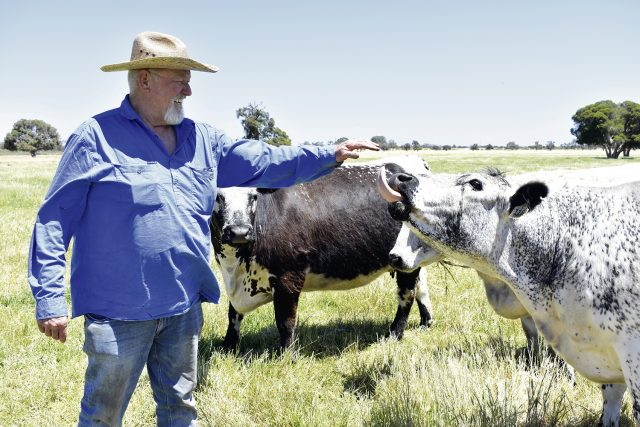It is a rare feat to transplant Canadians accustomed to their frosty climate into the scorching Australian paddocks and expect them to flourish. Nonetheless, this is the remarkable accomplishment of the Speckle Park cattle breed, equally at ease in their native Saskatchewan as they are in the expansive Northern Valleys and beyond.
A foundation breeder in Western Australia, Tony Trainor from Gingin Speckle Park Stud first came across speckle park cows in 2010. Experienced with both running cattle, “My family always had — not a farm, but a block we’d work, get clear and put cattle on it,” says Tony, and at the production end as a meat worker, Tony’s interest was piqued one day while casually flicking through The Weekly Times.
“There was this picture — a Speckle Park cross. I had a look at the length of it, and just thought, ‘That’s a good-looking animal!’”
The Speckle Park breed had their beginning in 1937, when a speckled Red Roan calf was born into the herd of the Lindsay family. Daughter Mary purchased the heifer from her father with the intention of breeding more speckled cattle, and her work caught the eye of ranchers Eileen and Bill Lamont in the late 1950s. The Lamonts thought the dappled cattle would complement their Appaloosa horses, but this initial aesthetic interest soon turned into a quest to develop a new breed. It was a slow process with the breed only declared as ‘evolving’ by the early nineties, and achieving distinct breed status in 2006.
While it is their distinctive colour patterns – speckled, leopard, white with black points, and solid black – that catch the eye of the casual cow observer, it is their hybrid vigour, fast growth and tender, flavoursome meat that make them an attractive option for breeders. Including Tony who, “After a lot of phone calls and mucking around,” sourced some embryos out of Canada and initiated the breed in Western Australia.
Tony has had tremendous success in the twelve years since those first embryos were implanted, and currently runs 55 purebred cows with more heifers coming through. Gingin Speckle stock can be found nearly nationwide — the Northern Territory being the exception — and though no longer showing cattle (that was daughter Emily’s passion and she has moved out of the area), they received many accolades at the Perth Royal Show, and Brunswick and Harvey Agricultural shows when they did. Tony is also a life member of Speckle Park International, the key registering body for the breed in Australia and New Zealand.

Speckle Park beef’s taste and texture profile is comparable to the lauded wagyu, but with one key difference — “It’s not rich like Wagyu,” says Tony. “I can’t eat that stuff! Speckle Park marbles well, it is tender and it has a distinct flavour, there’s no doubt about it.”
Butcher Jorden Healy from Northern Valleys Quality Meats agrees — “What sets Gingin Speckle meat apart is how well they are raised – from the quality of food they get, to how they are treated – it really shows in the finished product,” he said.
“The feedback from customers is always outstanding — I have never had a customer say a bad word about it.
“Demand is very high — once the customers know it is coming in, they usually put their name down for certain cuts straight away. It is very rare that it makes its way into our cabinet!
Taste aside, for Tony, there is one outstanding characteristic about the breed. “They are just so good at cross breeding,” he said. “You will get more meat and better quality. When you get paid by the kilo, it is simple maths.”
And this simple maths is at the forefront for many cattle producers this year. With the driest September on record (as a nation), and the effects of the El Nino weather phenomenon (warmer conditions, lower rainfall) set to continue through till early March, increased supply of cattle to saleyards has seen prices fall.
Tony says, “At the moment it is terrible — a lot of farmers will go close to losing money this year. This time last year, a good vealer around 10 months old…you get $2000 at the sale yards or butchers…now you would be lucky to get $600.”
In his capacity as a seed stock producer, Tony enjoys a certain degree of insulation from the prevailing economic climate, though it does emphasise why he fastidiously uses tools such as genetic testing and selective breeding, to ensure he is only supplying the best stock, and therefore maximising herd profitability for his clients.
Genetic testing is a requirement for all animals before registering and Tony says it, “Tells you absolutely everything — from estimated breeding values, how much milk it will produce to intramuscular fat, and size of the muscle.
“Everything on my property is registered and parent verified.”
Tony’s commitment to quality and integrity is also evident in his culling practice. “There’s many reasons why you might need to cull a cow – their feet have to be absolutely spot on, they might not produce enough milk or be producing good calves,” he explains. “That can take a few years to work out — you always give them the benefit of the doubt.”
He elaborates, “And there’s only one place my culled stock goes, and that’s the abattoir. That way, no one can buy them and say, ‘Well, I had Speckle Park cattle and they were wild, or produced no milk, etc.’
If you are keen to sample speckle park beef, Tony says your best bet is to get on the waitlist at Northern Valleys Quality Meats, or a less-convenient option — “We’ve got it for sale in The Rocks in Sydney,” he laughs.
You can keep an eye on the NVQM Facebook page or give them a call on 0422 152 553. To follow along with Tony’s progress, follow him @GinginSpeckleParkStud.








